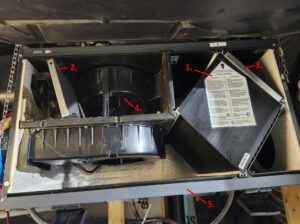With the arrival of warmer weather, it's time to think about preparing our homes for summer. This season, synonymous with warmth and relaxation, nevertheless requires specific maintenance for our living spaces. Indeed, this maintenance isn't just a matter of aesthetics, but crucial steps to ensure the longevity and efficiency of our home and its amenities. That's why we've put together this summer maintenance guide!
When temperatures rise, components like air conditioning systems and air exchangers play a vital role in maintaining a comfortable and healthy environment. Additionally, inspecting and maintaining your roof, gutters, and outdoor spaces are essential to prevent potential damage from summer weather. Proper maintenance helps prevent costly repairs and contributes to the preservation of your property's value.
Additionally, summer is the perfect opportunity to perform a general cleaning, both indoors and outdoors, to create a welcoming and pleasant space for you and your loved ones. By investing time and energy in summer home maintenance, you not only ensure optimal comfort during this season, but you also preserve the integrity and functionality of your home for years to come.
In the following sections, we'll guide you through a series of essential tasks and tips to best prepare your home for summer, focusing on each aspect of summer maintenance.
Prepare Your Home for Summer – Checklist
Now that we've highlighted the importance of taking care of your home in the summer, let's dive right into the concrete actions you need to take. The following list is your roadmap for comprehensive summer maintenance, ensuring every corner of your home is ready for the warmer months ahead:
- Air Conditioning Systems: Cleaning and Checking
- Clean filters for better air quality.
- Check ducts for optimal performance.
- Air exchanger: Maintenance and inspection
- Clean filters and fans for efficient air circulation.
- Control the system for optimized indoor air quality.
- Roofing: Inspection and maintenance
- Inspect tiles or shingles for damage.
- Clean up moss and debris to prevent water accumulation.
- Gutters: Cleaning and checking
- Remove debris for efficient water flow.
- Check and repair cracks and joints.
- Garden and outdoor spaces: Preparation and maintenance
- Prune plants and shrubs for a neat appearance.
- Maintain walkways and patios for a welcoming exterior.
- Security Systems: Verification and Maintenance
- Test smoke and carbon monoxide detectors for safety.
- Review locks and alarm systems for optimal protection.
- General cleaning and interior maintenance
- Clean windows for better brightness.
- Dust and clean surfaces for a healthy environment.
With this list in hand, move on to the next sections of the text to get more information about each of the interviews.
Maintenance of air conditioning systems
Maintaining your air conditioners is essential for their efficiency and longevity, especially during the hot summer months. Proper maintenance includes regularly cleaning filters and internal components, as well as checking the unit's overall performance. It's important to follow specific steps to ensure optimal operation.
Maintenance of air exchangers
Before we begin, the image above shows an example of an air exchanger. In my case, it's a Venmar unit. Here's the caption for this image:
- Heat recovery core
- Filters 1
- Filters 2
- Motor and fan
- Unit
Also, before anything else, don't forget to turn off the power to your equipment 🙂
Air exchangers play a crucial role in maintaining good indoor air quality and require regular maintenance to operate efficiently.
Here is the equipment as well as a cleaning and maintenance procedure for your air exchanger:
Material
- Air duster Or vacuum cleaner
- Hot water boiler and mild soap
- Dry cloth
Interview
1. Preparation for cleaning
Before you begin, turn off and unplug the appliance to ensure safety. Gather the necessary tools such as a vacuum cleaner, mild soap, warm water, a soft cloth, and a small brush.
2. Cleaning the exterior
Start by cleaning the exterior of the heat exchanger with a soft cloth and a mild soap solution. Then dry it with another clean cloth.
3. Cleaning the interior
Open the access panels and use a vacuum cleaner to remove dust and debris from inside the unit, including the fan blades.
4. Cleaning the filters
Remove the filters and clean them in a solution of mild soap and warm water. Rinse and allow to dry completely before replacing them. Filters should be cleaned every three months or more frequently depending on environment and usage.
5. Cleaning the heat recovery core
Remove and clean the heat recovery core according to the manufacturer's instructions. Use a mild soap solution, rinse, and dry thoroughly.
6. Drain and drain pan maintenance
Inspect and clean the drain and the bottom of the unit. Ensure the drain is not clogged by pouring a small amount of water into the bottom of the exchanger.
7. Reassembling the unit
Once all parts are cleaned and dry, reassemble the air exchanger. Check that everything is securely attached before turning the unit back on.
Scheduling Regular Cleaning and Maintenance
Regular cleaning, at least twice a year, is recommended to keep your air exchanger in good working order. Cleaning frequency may increase depending on household size, location, and outdoor environment.
By following these steps, you can effectively maintain your air exchanger, improving indoor air quality and extending its lifespan. If you are not comfortable with the cleaning process, it is advisable to call a professional.
Roofing – Inspection and Maintenance
The roof is a crucial part of your home, protecting it from the elements and contributing to its energy efficiency. Here's a recommended procedure for inspecting and maintaining your roof:
Roof Inspection
- Visual Inspection : Inspect your roof at least twice a year, especially after harsh seasons like winter. Pay attention to missing, damaged, or lifting shingles, as well as the overall condition of the roof.
- Checking Walls and Ceilings : Look for signs of water infiltration such as damp patches, peeling paint, or cracks on interior walls and ceilings.
- Roof Drains on Flat Roofs : Ensure drains are not clogged to prevent water accumulation and infiltration.
Roof Maintenance
- Gutter Cleaning : Empty gutters regularly to prevent blockages and overflows, which can cause damage to the roof and gutters.
- Snow removal : In winter, make sure that too much snow is not accumulated on the roof, as it can be heavy and cause damage.
- Moss removal : Remove moss from your roof with a brush and a product suited to your roof type. Moss removal helps prevent water infiltration.
- Anti-moss and water-repellent treatment : Apply specific treatments to protect the roof against moss and dirt, and to improve its waterproofing.
- Checking Seals and Membranes : On membrane roofs, check the condition of the waterproof joints to prevent water infiltration.
When to do a roof inspection and maintenance?
- Perform an annual inspection to identify potential problems and take prompt action.
- After purchasing a property, make sure the roof is in good condition.
- Preventative maintenance can be performed in the fall or spring, and after significant weather events.
Call a professional
- For a thorough inspection and specialized maintenance, it is recommended to hire a professional. This is especially important for complex or sloping roofs.
Regular inspection and maintenance of your roof can prevent many problems and extend its lifespan. By remaining vigilant and responding quickly to any problems, you will effectively protect your home from the elements.
Gutters – Cleaning and checking
Cleaning and inspecting your gutters are essential tasks for maintaining the integrity of your home. Proper gutter maintenance helps ensure proper rainwater drainage and prevent leaks and water damage. Here's a recommended procedure for gutter maintenance:
Gutter Cleaning
- Debris Cleanup : Start by removing dead leaves, branches, and other debris that may be clogging the gutters. Use a small shovel or brush to clean the inside of the gutters.
- Washing : After removing the debris, wash the inside of the gutters with a jet of water to remove residue and dirt.
- Evacuation Check : Make sure your drainpipes and downspouts are not blocked. You can clean them by pouring water through them to check that they are draining properly.
Checking and Repairs
- Leak Control : Temporarily block the lower part of the gutter and run water through it to detect any leaks.
- Checking the Fasteners : Inspect the mounting brackets, gaskets, and connections. Repair or tighten any damaged parts if necessary.
- General Inspection : Check the general condition of the gutters, looking for signs of corrosion or wear.
Frequency and Tips
- Gutter maintenance should be carried out at least twice a year, ideally in the fall and spring.
- For homes with gutters located at high altitudes or difficult to access, it is advisable to hire a professional. A professional roofer will have the necessary equipment to complete the job safely.
Regular gutter maintenance is crucial to prevent water damage and maintain the integrity of your roof and facade. It's important not to neglect this task to avoid costly repairs in the future.
Garden and outdoor spaces – Preparation and maintenance
Pruning plants and shrubs
Pruning plants and shrubs is essential to maintain their aesthetics and good health. Here are some general pruning tips:
- Plant Type Identification : Determine whether your shrubs are spring-flowering, summer-flowering, or evergreen or deciduous, as this will influence when to prune.
- Pruning Period :
- Spring-flowering shrubs: Prune them just after flowering, often in early summer.
- Summer-flowering shrubs: Start with a light pruning in late winter, then after flowering, rebalance the overall shape of the shrub.
- Evergreen shrubs: Prune them in late winter for the main shape, then lightly in early summer and autumn to maintain the silhouette.
- Pruning Techniques : Use appropriate tools such as pruning shears and make clean cuts. For flowering shrubs, shorten flowering shoots after flowering. For bushy shrubs, such as lavender or thyme, cut back two-thirds of the new stems.
Maintenance of driveways and patios
- Cleaning : Sweep regularly to remove leaves, soil, and other debris. Use a pressure washer to remove stubborn stains and moss.
- Repair : Inspect driveways and patios for cracks or loose slabs. Repair them if necessary using proper materials, such as grout.
Regular maintenance of your garden and outdoor spaces, including pruning plants and shrubs and cleaning and repairing paths and patios, will help create a pleasant and welcoming outdoor environment.
For more detailed information on pruning shrubs, you can consult resources like Truffaut, Smart Gardening, and Inès & JulieThese sites offer in-depth advice on optimal pruning times, specific techniques, and tools needed for different types of shrubs and plants.
Checking security systems
Smoke and carbon monoxide detectors
Checking your smoke and carbon monoxide detectors is crucial to ensuring the safety of your home. Here are some tips for maintaining them:
- Test the detectors regularly : Test your detectors once a month by pressing the test button.
- Replacing the detectors : Replace smoke detectors every 7 to 10 years and carbon monoxide detectors every 5 to 7 years, as sensors can deteriorate over time.
- Changing the batteries : Replace the batteries in the detectors at least once a year, even for wired devices that have backup batteries.
- Proper placement : Install smoke detectors on the ceiling because smoke rises, while carbon monoxide detectors should be placed on the walls, near boilers or gas heaters.
Maintenance of locks and alarm systems
- Check and lubricate the locks : Make sure the locks on your doors and windows are working properly. Use a suitable lubricant if necessary to prevent the locks from seizing.
- Alarm system control : Regularly test your alarm system following the manufacturer's instructions to ensure it is working properly.
- Professional maintenance : Consider hiring a professional for regular maintenance of complex alarm systems to ensure they are functioning properly.
By regularly maintaining your security systems, you help prevent the risks of fire, carbon monoxide poisoning and break-ins, thus ensuring the safety of your home and its occupants.
General cleaning and interior maintenance
Spring cleaning is an ancient tradition that symbolizes renewal, perfect for revitalizing and refreshing your home. Here are some effective strategies for a thorough cleaning and optimal organization of your interior spaces.
Strategies for Effective Spring Cleaning
- Planning : Break your cleaning down into manageable tasks spread over several days or weekends. This will help you avoid feeling overwhelmed and stay organized.
- Gathering the necessary products : Use natural cleaning products, such as white vinegar, baking soda, and black soap. These products are effective and environmentally friendly.
- Room by room cleaning : Approach each room individually, starting with the most used areas like the kitchen and living room. In the kitchen, clean appliances, walls, cabinets, and food items. In the living room, focus on seats, cushions, and armchairs, and vacuum the floor.
- Use of specific cleaning techniques : For specific surfaces, such as faucets, use tricks such as applying white vinegar to remove limescale. For walls, use a mild soap and water solution to remove dirt without damaging paint or wallpaper.
Organization and decluttering of interior spaces
- KonMari Method : Use Marie Kondo's approach to decluttering. This involves keeping only the items that bring you joy and thanking those you decide to let go.
- Storage areas : Organize your storage spaces, such as cabinets and closets, to maximize space and make items easily accessible.
- Seasonal storage : Store clothes and other seasonal items to free up space in your home.
- Reducing clutter : Sort through your belongings, eliminating unnecessary or rarely used items. This helps maintain an orderly and functional living space.
By following these steps and taking the necessary time, your spring cleaning will not only be effective, but also rewarding, leaving you with a revitalized and organized space ready for the new season.
Conclusion
With summer fast approaching, preparing your home with a thorough home maintenance program is essential. This approach not only enhances the aesthetics of your living space, but also plays a crucial role in preserving its structural and functional integrity. From maintaining your air conditioning and heat exchanger systems to thoroughly inspecting your roof and gutters, each step helps ensure the durability and safety of your home. Additionally, interior organization and decluttering, along with general cleaning, create a healthy and pleasant environment for you and your loved ones.
By following this summer maintenance guide, you'll not only ensure a comfortable and stress-free summer, but you'll also help maintain and improve the value of your property. Regular maintenance is key to avoiding costly repairs in the future and fully enjoying your home during the warmer months. Remember, a well-maintained home is a source of pride and peace of mind.






